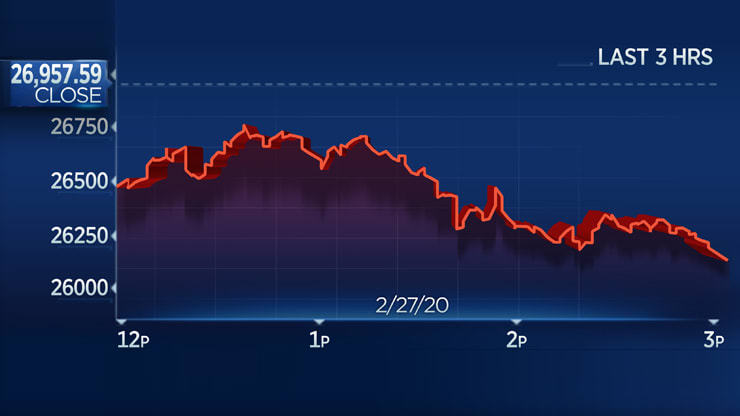
FILE PHOTO: A man with a face mask rides the subway in the Queens borough of New York City, U.S. February 2, 2020. Picture taken February 2, 2020. REUTERS/Nick Zieminski – RC27TE9RK4CY/File Photo
February 27, 2020
By Ann Saphir and Anthony Esposito
SAN FRANCISCO/MEXICO CITY (Reuters) – The Federal Reserve may need to move aggressively to cut borrowing costs to cushion the economy from the rapid spread of the new coronavirus, in part because interest rates are already low and so is inflation.
Traders of futures contracts tied to the U.S. central bank’s policy rate are already betting on it. On Thursday they were pricing in about a 54% chance of the Fed starting to cut rates as soon as next month and trimming an extraordinary three-fourths of a percentage point by September, according to CME Group’s FedWatch.
That would bring the short-term target rate to below 1% for the first time since 2017.
Traders saw just a 33% chance of a March rate cut on Wednesday. But that was before a report showing new cases in Iran, Italy and elsewhere were growing faster than in the outbreak’s epicenter of China, and leaders around the world began rallying their nations to prepare for a broader epidemic.
Global central bankers, facing an economic threat from the virus, have for the most part taken a wait-and-see approach.
European Central Bank President Christine Lagarde said on Thursday that she would need to see a “long-lasting” shock to act, adding that it has “certainly” not gotten to that point yet. In South Korea, home to one of the biggest outbreaks outside of China, the central bank unexpectedly held its fire on rate cuts.
Unlike many other central banks, the Fed still has some room to cut interest rates, although officials there have said that they want to see a “material change” in the economic data before they take further action after cutting rates three times last year.
At the same time, though, they have warned that with inflation already low, any response to an economic shock may need to be supercharged to have an effect.
On Thursday Chicago Fed President Charles Evans told a central banking conference in Mexico City that with limited room to cut interest rates and a downward pull on inflation, “policymakers must commit to provide extraordinary accommodation in order to meet their mandate.”
(GRAPHIC: The 5-year, 5-year foward breakeven inflation rate – https://fingfx.thomsonreuters.com/gfx/mkt/13/2608/2573/Pasted%20Image.jpg)
Asked about the impact of the coronavirus directly, Evans said the Fed is paying “close attention,” although he reiterated what appears to be the consensus view at the Fed: that the effect on the economy will be transitory.
VIRUS ALREADY HURTING COMPANIES
Some major U.S. corporations say the virus is already weakening their balance sheets and hitting earnings.
Best Buy Co Inc <BBY.N> on Thursday lowered its forecast for annual profits, citing a slowdown in manufacturing by electronics companies that could hit sales. And last week, Apple warned it could miss revenue targets for the first quarter of 2020 because production in manufacturing sites in China was lower than expected, limiting global iPhone supplies.
Wall Street’s main indexes accelerated a days-long tumble on Thursday, with the S&P 500 <.SPX> and Nasdaq <.IXIC> dropping as much as 10% from their intraday record highs hit on Feb. 19, and the Dow Jones Industrials <.DJI> down as much as 10% from its Feb. 12 peak.
“The Fed’s desire to be data-dependent may capitulate to market sentiment,” said Jon Hill, an interest rates strategist at BMO Capital Markets.
Worries about the spread of the coronavirus have also contributed to a drop in inflation expectations, a trend policymakers are battling out of concern that low rates leave them with less ammunition to counter the next downturn. Fed Vice Chair Richard Clarida said on Tuesday that inflation expectations were “at the low end of a range I consider consistent with our price-stability mandate.”
That could get worse if the new coronavirus continues to spread, predicted JPMorgan’s chief U.S. economist Michael Feroli, in part because a decline in oil prices due to reduced global demand could feed into lower prices for U.S. goods and services.
The flu-like illness, which originated in China, has killed 2,800 and infected about 80,000. But in the recent 24 hours, new cases abroad surpassed those in mainland China, where the spread of the pathogen is on the decline after an aggressive containment campaign that included travel limits and factory shutdowns.
In a sign of growing concern about the spread of the disease, U.S. President Donald Trump on Wednesday appointed Vice President Mike Pence to head public health efforts to contain the virus’ spread.
(Reporting by Ann Saphir and Jonnelle Marte, Additional reporting by Lindsay Dunsmuir; Editing by Chizu Nomiyama, Nick Zieminski and Andrea Ricci)

